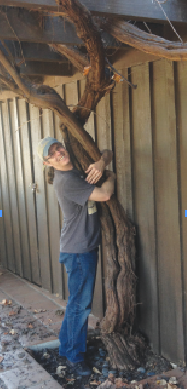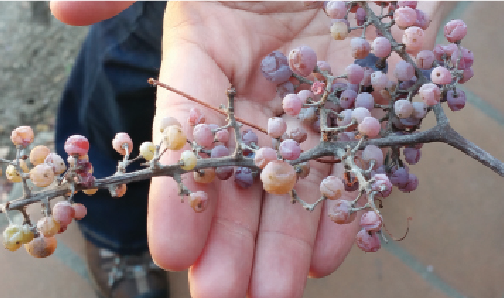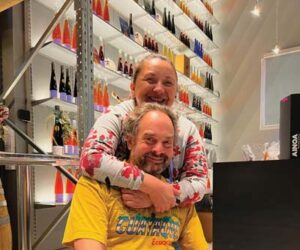 Like all good stories, this one starts over a few flagons of wine. I was hosting a winemaker dinner in Pasadena, California recently and the topic of conversation was the history of wine. My suggestion that night, with a headful of Pinot Noir and only minimal reading on the subject, was that Los Angeles was the first winegrowing area in the New World to have success growing Vitis vinifera, and that the Missions in the Los Angeles area had a strong influence on the genesis of Southern California winegrowing.
Like all good stories, this one starts over a few flagons of wine. I was hosting a winemaker dinner in Pasadena, California recently and the topic of conversation was the history of wine. My suggestion that night, with a headful of Pinot Noir and only minimal reading on the subject, was that Los Angeles was the first winegrowing area in the New World to have success growing Vitis vinifera, and that the Missions in the Los Angeles area had a strong influence on the genesis of Southern California winegrowing.
A very good customer of my family’s wines, Michael Holland (along with his mystery-novelist wife Anne), were in attendance and I was spending more time at their table than any other. Mr. Holland is the City Archivist for the City of Los Angeles and was interested in Los Angeles wine history, and I was fascinated with a story he told. Holland was infatuated by the history of a living vine at the oldest standing structure in Los Angeles — the Avila Adobe on Olvera Street, a building completed in 1818. Near his archive, Michael would walk past the ‘Pueblo’ (old Olvera Street) commonly and continued to notice that the Avila Adobe vine was struggling beneath 200 years of growth, but was still heroically producing clusters of fruit each vintage. As a home winemaker with no vineyards of his own, the clusters begged to be crushed and fermented. But as an archivist, Holland had more questions than answers before harvest: Where did the Avila Adobe vine come from and what variety was it? Had wine ever been produced from this venerable ‘grandmother’? How old was the vine? Could it make wine again? And was the vine dying from neglect?
Holland and I decided to team up. I would do the pruning/viticulture, he would do the winemaking. Together we would explore the history of LA winemaking in the most practical and visceral way possible: prune, harvest, ferment, DRINK!
Our first goal was to determine the parentage of the vine and the source of the material/cutting. Michael Holland asked me to recommend a lab to test the vine’s DNA, and my first choice was the Foundation Plant Material Service (FPMS) at UC-Davis. I received an excited email back from Michael that UC-Davis and FPMS had not only decided to accept a tissue analysis, but to do it for free because of the historic nature of the vine.
Tissue was collected and sent to FPMS and we waited with great anticipation for the results. The discovery was thrilling and historic. The vine was a direct descendent of the Vina Madre from the Mission San Gabriel (Arcangel) from plantings that stretch back to the late 1700s. Mission San Gabriel was a magical terroir for the Mission grape, and the friars grew enough Mission grapes in San Gabriel to furnish sacramental wine throughout California.
The Mission grape, long thought to be a Spanish/American hybrid, was confirmed in 2007 by DNA analysis at the Centro Nacional de Biotecnología in Madrid, to be Red Palomino or Listan Prieto. This grape variety is a rare selection limited in antiquity to the Castilian regions of Spain and unusual in modern viticulture outside of the Canary Islands.
Now Michael and I knew what the vine was. It was a Mission grape (Red Palomino) cutting from the San Gabriel Mission’s Vina Madre, a direct link to the earliest days of 18th century California Mission winegrowing and Founding Father of the San Gabriel Mission: Junipero Serra. Others became interested as well. S. Irene Virbila from the Los Angeles Times wrote a feature story on the vine and its history, including a timeline of Los Angeles winemaking, which you can read by going to www.latimes.com/food/drinks/la-fo-0919-pueblo-20150919-story.html.
Now the vine was gaining fame but we still had some work to nurture the vine back to health and make some wine from it. And more questions continued to surface.
How old was the Avila Adobe grapevine, and is there an older vinifera vine in California, or even the United States? Thomas Jefferson’s 1807 vinifera project at Monticello, Virginia failed horribly and the vines were removed without ever making wine from them. But what of the ‘mother vine’ at San Gabriel Mission? Was the living vine in San Gabriel older than the Avila Adobe vine? To answer that question, I had to do some history homework. What I found was a peer-reviewed entry that confirms Francisco Avila tended his vineyard at the Avila Adobe. Since the Avila Adobe was built in 1818 and F. Avila died in 1932, the vine must have been mature enough to tend by 1832, which guarantees the vine was planted no later than the 1820s, and (by my best hypothesis) the vine was planted at the completion of the Adobe’s construction by 1820.
How about the question of wine? Was wine ever made from the Avila Adobe vine? Thus far we can find no confirmation in the archives that wine was made from Francisco Avila’s vine. But the fact that Red Palomino/Mission tends to throw a good crop and give a good yield guarantees that the sweet, ripe grapes were not wasted. Were they eaten by Olvera Street’s early citizens? Were they left for the birds? It is clear to me after spending a number of hours in the vine at the Adobe that the purpose of this patio/pergola-trained vine was shade and comfort. Like the ancient Egyptians, patios covered with grapevine canopy were a valuable source of protection from the hot sun. But the Egyptians left behind cartouches that showed these pergolas were harvested for wine production. For now we have to use our imagination in reconstructing the uses for the Adobe’s grape crop. I would suggest some of the fruit was eaten fresh, some was likely turned into preserves, much was eaten by birds and animals, and of course there is a strong chance (especially with the prevalence of winemaking knowledge and technology available within a stone’s throw), some fruit was likely fermented and consumed as wine. With scores of wineries surrounding the Avila Adobe in the first century of its life, it would be easy to imagine Avila’s wife, family or later inhabitants harvesting ripe fruit and bringing it to a nearby winery to be added to the winery’s ‘cuvée,’ receiving some jugs of wine in recompense for the fruit. But with no evidence of Avila Adobe winemaking, the 2015 vintage of Angelica wine (50/50 wine and white brandy) is the first confirmed fermented and quaffable beverage ever made from the ancient vine. Michael Holland (a home winemaker as well as an archivist) did an amazing job producing about 4 gallons (15 L) of wine from the vine last year. I was able to taste the wine a few weeks back, and I was very impressed.

My tasting note: “2015 Angelica from the 1818(?) Avila Adobe vine in Los Angeles. Electric pink in color, a rare non-oxidized style of Angelica and very well made. The oldest-vine wine I know of in the US (less than 2 cases produced). Bright cranberry, vinous Port aroma, hint of VA, unripe raspberry, spirituous. Balanced and fresh in the mouth with admirable acidity.” The wine was good. Now to nourish the vine back to health to get a greater yield!
After gaining approval from the management of the ‘Paseo’/L.A. Plaza Historic District, I was asked to visit the Adobe vine and determine if it could be safely pruned and nurtured back to a healthier state. I brought my bypass pruners knowing that a good pruning was almost certainly in order. It was. I spent three days pruning. The vine covers 400 square feet of pergola canopy and decades of dead growth and leaf litter choke the canopy from getting the sun it needs to activate fruitfulness, keeping the vine virtually buried in a layered sandwich of detritus.
Final goal: With the Bicentennial of the Avila Adobe approaching in 23 months, we are hard pressed to get the vine healthy, balanced and producing wine. I would love to think that a properly pruned Avila Adobe vine (still challenged by drought and nutrient deficiencies) could produce at least 30 gallons (114 L) of Angelica by the 200th anniversary of the Adobe, and could provide a source of funding (through auctioning the wine and cuttings) to keep the Avila Adobe (the oldest standing structure in LA) and its Grandmother Vine (the oldest live/producing vinifera vine in the US?), properly managed and tended well into the next century. As a 3rd generation Los Angelean, this is my goal and my dream. LA was growing wine grapes when Napa was awash in prunes, pines, and cattle. My job is to let people know who had the original wine country. It may take until the Lakers win another NBA Championship, so we have plenty of time.






